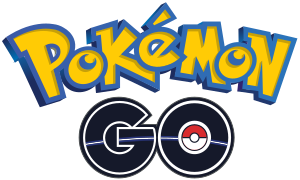Pokémon Go
Pokémon Go is a 2016 augmented reality (AR) mobile game developed and published by Niantic in collaboration with Nintendo and The Pokémon Company for iOS and Android devices. A part of the Pokémon franchise, the game is the result of a collaboration between Niantic, Nintendo and The Pokémon Company. It uses mobile devices with GPS to locate, capture, train, and battle virtual creatures, called Pokémon, which appear as if they are in the player's real-world location. The game is free-to-play; it uses a freemium business model combined with local advertising and supports in-app purchases for additional in-game items. The game launched with around 150 species of Pokémon, which had increased to around 600 by 2020.
Pokémon Go was released to mixed reviews; critics praised the concept but criticized technical problems. It was one of the most used and profitable mobile apps in 2016, having been downloaded more than 500 million times worldwide by the end of the year. It is credited with popularizing location-based and AR technology, promoting physical activity, and helping local businesses grow due to increased foot traffic. However, it attracted controversy for contributing to accidents and creating public nuisances. Various governments expressed concerns about security, and some countries regulate its use. The game had over 147 million monthly active users by May 2018, over a billion global downloads by early 2019, and grossed more than $6 billion in revenue as of 2020.[1]
Racist accusation to Pokémon Go
Within days of the launch of “Pokémon Go,” a number of sites and museums started complaining that they were not appropriate places to catch 'em all. Formerly public sites turned private were also reported as being marked as "pokéstops" or "gyms." Some areas had the opposite problem: no pokéstops at all. Some social media users observed that their small town and rural neighborhoods lacked any pokéstops, though urban areas had plenty.[2]
A Pokemon Go player has accused the game and its developer Niantic of putting Poke Stops, real-world locations where players get items, in predominately white neighborhoods. Aura Bogado, an environmental reporter for news outlet Grist, began to notice the issue when the game was released on July 2016.
She said when walking around Long Beach, California, which is 50 per cent white, she noticed there were far more Poke Stops than in her Los Angeles neighborhood, comprised of mainly minorities. Bogado created the hashtag #mypokehood to crowdsource and document Poke Stop locations. As results came in, Bogado began to confirm her suspicion that minority-heavy areas had fewer Poke Stops.[3]
Urban Institute researchers found an average of 55 PokéStops in majority white neighborhoods and 19 in majority black neighborhoods. The Belleville News-Democrat found that pattern repeated itself in African-American sections of Detroit, Miami and Chicago. Similarly, New York boroughs Brooklyn and Queens, both of which have high numbers of Hispanic and black residents, had significantly fewer PokéStops than in Manhattan and white and Asian neighborhoods.[4] The Urban Institute calls the disparity 'redlining', which is a term meaning a community that is cut off from essential services due to ethnic make up or race.[3]
However, this disparity may just be the result of the game developer Niantic's use of a previous game that allowed users to mark real-life locations as in-game battle sites. The Urban Institute calls the disparity 'redlining', which is a term meaning a community that is cut off from essential services due to ethnic make up or race. Because their are fewer stops in these neighborhoods, residents find it more difficult to play and participate in the game.[3]
References
- ↑ Pokémon Go. Wikipedia. Retrieved Feb 3, 2021.
- ↑ Huffaker, Christopher. There are fewer Pokemon Go locations in black neighborhoods, but why?. July 13, 2016. idahostatesmen.com. Retrieved Feb 3, 2021.
- ↑ Jump up to: 3.0 3.1 3.2 Rosenblatt, Kalhan (2016). Why are there so many more Poke Stops and gyms in white neighborhoods than black?. Daily Mail. Retrieved January 18, 2021.
- ↑ Akhtar, Allana (2016). Is Pokémon Go racist? How the app may be redlining communities of color. USA Today. Retrieved January 18, 2021.

